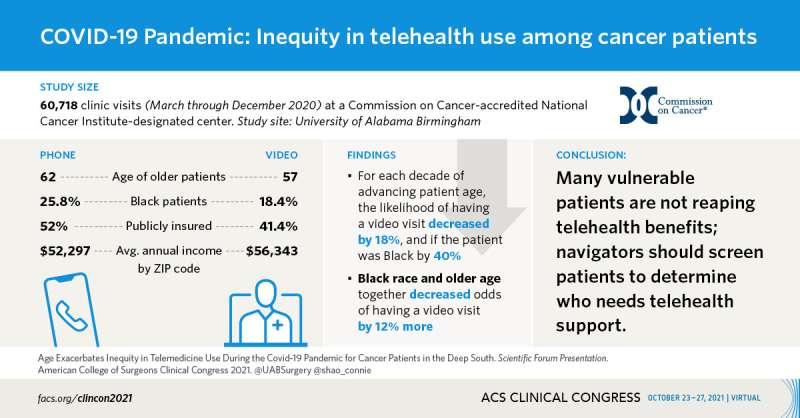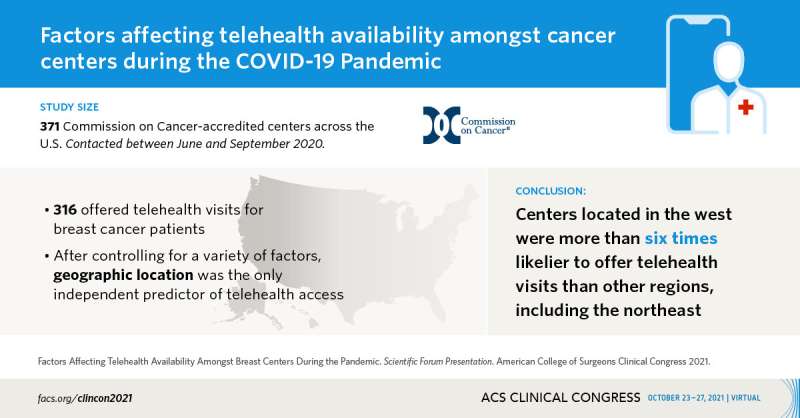Region, race, and age linked with likelihood of cancer patients using telehealth services

Two studies improve understanding of how video and telephone telehealth services are used by patients and cancer centers across the country, identifying factors that could lead to more or less use of these services and guide efforts to improve access for patients who might otherwise be shut out. Research findings were presented at the virtual American College of Surgeons (ACS) Clinical Congress 2021.
To improve access to care during the COVID-19 pandemic, many medical centers shifted to telehealth services. In fact, telehealth visits increased by 50 percent during the first quarter of 2020, compared with the same period in 2019, according to the CDC.
Telehealth appointments are more efficient than traditional face-to-face encounters, eliminating the need for long travel and wait times, plus many patients prefer the convenience of remote visits. However, challenges for patients such as technical difficulties, internet connection issues, and limited access to smart devices can prevent patients from using this approach.
"Because of COVID, centers across the country had to ramp up telehealth services, and that begs the question, is it feasible for these centers to make this shift long-term?" said Harry Doernberg, a medical student at Yale School of Medicine, New Haven, Connecticut.
Telehealth use among Commission on Cancer-accredited centers
For the first study, Mr. Doernberg and colleagues addressed this question by conducting a secret shopper study on 371 ACS Commission on Cancer (CoC)-accredited centers across the U.S. The objective was to identify factors associated with the centers who offered telehealth services and those who did not. Between June and September 2020, researchers called the centers anonymously to find out if they had the capacity to offer telehealth appointments to breast cancer patients.
Among the study's key findings:
- The vast majority of CoC-accredited centers (316 of 371) offered telehealth visits for breast cancer patients.
- After controlling for facility type (Comprehensive Community Cancer Program, Community Cancer Program, and more), teaching hospital status, and hospital size, geographic location was the only independent factor associated with telehealth access.
- Centers located in the west were over six times (OR: 6.38) more likely to offer telehealth visits than other regions, including the northeast.
"Overall, this analysis highlights the fact that different regions of the country were more or less prepared to shift to telehealth during the pandemic," said study coauthor Anees Chagpar, MD, MBA, MPH, FACS, FRCS (C), professor of surgery, Yale School of Medicine, and a member of Yale Cancer Center. "The next questions are: What happens going forward? How many of these centers will continue to offer telehealth? What percentage of patients will opt for telehealth visits? How these questions play out in the future remains to be seen."
Telehealth use among a diverse population
For the second study, Connie Shao, MD, a general surgery resident at the University of Alabama Birmingham, and her colleagues looked at telehealth use between March and December 2020 among a diverse population of patients receiving care at a Commission on Cancer-accredited National Cancer Institute-designated cancer center in Birmingham.
Using billing data, researchers compared patient socioecological factors for outpatient clinic visits (in-person versus telehealth and within telehealth, telephone-only versus video). The analysis adjusted for factors such as zip code, household income, race, and sex to identify factors associated with telehealth use.

Among the key findings:
- Of the 60,718 clinic visits, 84.4 percent (51,260) were in-person and 15.6 percent (9,458) were via telehealth, including video (41.7 percent) and telephone-only (58.3 percent) visits.
- Telehealth visits were primarily used by patients who were white (70.3 percent), female (63.7 percent), and had private insurance (47.5 percent). Average age was 60.
- Compared with video visits, telephone visits were used more by patients who are Black (25.8 percent vs. 18.4 percent), older (62 vs. 57), from lower income zip codes ($52,297 vs. $56,343), and publicly insured (52 percent vs. 41.4 percent).
- For each decade of advancing patient age, the likelihood of having a video visit decreased by 18 percent. This was even more pronounced in Black patients where the likelihood of a video visit dropped by 40 percent for every decade. When Black race and older age were combined, the odds of having a video visit dropped by another 12 percent. This finding was despite increased video telehealth use over the study period.
"Telemedicine is here to stay," Dr. Shao said. "The issue is how do we make sure patients are accessing it equitably? Unfortunately, some of our sickest patients are not able to access telemedicine that most benefits their health care needs. We want to offer patients, those who are far from the hospital and have a difficult time connecting with us, care with us, even as the COVID pandemic hopefully ends."
Although telemedicine has been available for decades, COVID has accelerated its widespread use very quickly. Together, these two studies deepen understanding of how vulnerable patients are not reaping the benefits of its use, paving the way for additional research and improved access.
Currently, Dr. Shao and colleagues are implementing a process at their center where patient navigators screen patients to figure out who needs telehealth support. The patient navigators instruct patients on how to set up a video-based telemedicine visit. This gives patients the skill and confidence to use telehealth video visits now and for future appointments.
"We are currently collaborating with a group to roll out this program even more and to analyze the strength of the program and eliminate the barriers. We want to know what can be improved to achieve successful telemedicine visits," Dr. Shao said. "As COVID wanes, the fear of coming into the hospital decreases. Moving forward, our concern is finding ways to help those patients better engage with us, often and remotely. A lot of these patients are rural and live hours away from a major hospital."
Coauthors for the Yale University School of Medicine study are Walter Hsiang, BS, MBA; Victoria Marks, BS; Irene Pak; Dana Kim; Bayan Galal; Waez Umer; and Afash Haleem.
More information: Doernberg H, et al. Factors Affecting Telehealth Availability Amongst Breast Centers During the Pandemic. Scientific Forum Presentation. American College of Surgeons Clinical Congress 2021.




















